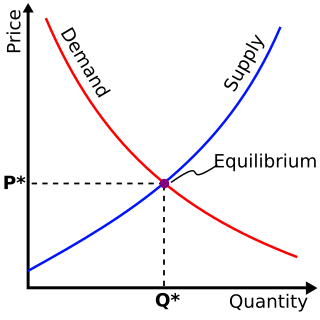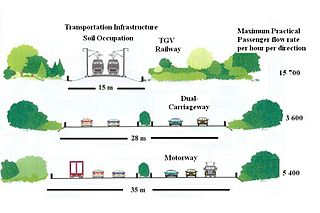Logrolling is the trading of favors, or quid pro quo, such as vote trading by legislative members to obtain passage of actions of interest to each legislative member. In organizational analysis, it refers to a practice in which different organizations promote each other's agendas, each in the expectation that the other will reciprocate. In an academic context, the Nuttall Encyclopedia describes logrolling as "mutual praise by authors of each other's work". Where intricate tactics or strategy are involved, the process may be called horse trading.
Cost accounting is defined by the Institute of Management Accountants as "a systematic set of procedures for recording and reporting measurements of the cost of manufacturing goods and performing services in the aggregate and in detail. It includes methods for recognizing, allocating, aggregating and reporting such costs and comparing them with standard costs". Often considered a subset of managerial accounting, its end goal is to advise the management on how to optimize business practices and processes based on cost efficiency and capability. Cost accounting provides the detailed cost information that management needs to control current operations and plan for the future.

In microeconomic theory, the opportunity cost of a choice is the value of the best alternative forgone where, given limited resources, a choice needs to be made between several mutually exclusive alternatives. Assuming the best choice is made, it is the "cost" incurred by not enjoying the benefit that would have been had if the second best available choice had been taken instead. The New Oxford American Dictionary defines it as "the loss of potential gain from other alternatives when one alternative is chosen". As a representation of the relationship between scarcity and choice, the objective of opportunity cost is to ensure efficient use of scarce resources. It incorporates all associated costs of a decision, both explicit and implicit. Thus, opportunity costs are not restricted to monetary or financial costs: the real cost of output forgone, lost time, pleasure, or any other benefit that provides utility should also be considered an opportunity cost.

Transport economics is a branch of economics founded in 1959 by American economist John R. Meyer that deals with the allocation of resources within the transport sector. It has strong links to civil engineering. Transport economics differs from some other branches of economics in that the assumption of a spaceless, instantaneous economy does not hold. People and goods flow over networks at certain speeds. Demands peak. Advance ticket purchase is often induced by lower fares. The networks themselves may or may not be competitive. A single trip may require the bundling of services provided by several firms, agencies and modes.
The net present value (NPV) or net present worth (NPW) is a way of measuring the value of an asset that has cashflow by adding up the present value of all the future cash flows that asset will generate. The present value of a cash flow depends on the interval of time between now and the cash flow because of the Time value of money. It provides a method for evaluating and comparing capital projects or financial products with cash flows spread over time, as in loans, investments, payouts from insurance contracts plus many other applications.

In economics, an externality or external cost is an indirect cost or benefit to an uninvolved third party that arises as an effect of another party's activity. Externalities can be considered as unpriced components that are involved in either consumer or producer market transactions. Air pollution from motor vehicles is one example. The cost of air pollution to society is not paid by either the producers or users of motorized transport to the rest of society. Water pollution from mills and factories is another example. All (water) consumers are made worse off by pollution but are not compensated by the market for this damage. A positive externality is when an individual's consumption in a market increases the well-being of others, but the individual does not charge the third party for the benefit. The third party is essentially getting a free product. An example of this might be the apartment above a bakery receiving some free heat in winter. The people who live in the apartment do not compensate the bakery for this benefit.
In economics and business decision-making, a sunk cost is a cost that has already been incurred and cannot be recovered. Sunk costs are contrasted with prospective costs, which are future costs that may be avoided if action is taken. In other words, a sunk cost is a sum paid in the past that is no longer relevant to decisions about the future. Even though economists argue that sunk costs are no longer relevant to future rational decision-making, people in everyday life often take previous expenditures in situations, such as repairing a car or house, into their future decisions regarding those properties.
Environmental full-cost accounting (EFCA) is a method of cost accounting that traces direct costs and allocates indirect costs by collecting and presenting information about the possible environmental costs and benefits or advantages – in short, about the "triple bottom line" – for each proposed alternative. It is one aspect of true cost accounting (TCA), along with Human capital and Social capital. As definitions for "true" and "full" are inherently subjective, experts consider both terms problematic.
Cost–benefit analysis (CBA), sometimes also called benefit–cost analysis, is a systematic approach to estimating the strengths and weaknesses of alternatives. It is used to determine options which provide the best approach to achieving benefits while preserving savings in, for example, transactions, activities, and functional business requirements. A CBA may be used to compare completed or potential courses of action, and to estimate or evaluate the value against the cost of a decision, project, or policy. It is commonly used to evaluate business or policy decisions, commercial transactions, and project investments. For example, the U.S. Securities and Exchange Commission must conduct cost-benefit analyses before instituting regulations or deregulations.
Total cost of ownership (TCO) is a financial estimate intended to help buyers and owners determine the direct and indirect costs of a product or service. It is a management accounting concept that can be used in full cost accounting or even ecological economics where it includes social costs.
Cost–utility analysis (CUA) is a form of economic analysis used to guide procurement decisions. The most common and well-known application of this analysis is in pharmacoeconomics, especially health technology assessment (HTA).

Sustainable urban infrastructure expands on the concept of urban infrastructure by adding the sustainability element with the expectation of improved and more resilient urban development. In the construction and physical and organizational structures that enable cities to function, sustainability also aims to meet the needs of the present generation without compromising the capabilities of the future generations.

A shadow price is the monetary value assigned to an abstract or intangible commodity which is not traded in the marketplace. This often takes the form of an externality. Shadow prices are also known as the recalculation of known market prices in order to account for the presence of distortionary market instruments. Shadow prices are the real economic prices given to goods and services after they have been appropriately adjusted by removing distortionary market instruments and incorporating the societal impact of the respective good or service. A shadow price is often calculated based on a group of assumptions and estimates because it lacks reliable data, so it is subjective and somewhat inaccurate.
The Ministry of Energy is a Cabinet-level agency of the government of the Canadian province of Alberta responsible for coordinating policy relating to the development of mineral and energy resources. It is also responsible for assessing and collecting non-renewable resource (NRR) royalties, freehold mineral taxes, rentals, and bonuses. The Alberta Petroleum Marketing Commission, which is fully integrated with the Department of Energy within the ministry, and fully funded by the Crown, accepts delivery of the Crown's royalty share of conventional crude oil and sells it at the current market value. The current ministry was formed in 1986, but ministries with other names dealing with energy resources go back to the Ministry of Lands and Mines in 1930.
Social discount rate (SDR) is the discount rate used in computing the value of funds spent on social projects. Discount rates are used to put a present value on costs and benefits that will occur at a later date. Determining this rate is not always easy and can be the subject of discrepancies in the true net benefit to certain projects, plans and policies. The discount rate is considered as a critical element in cost–benefit analysis when the costs and the benefits differ in their distribution over time, this usually occurs when the project that is being studied is over a long period of time.

Engineering economics, previously known as engineering economy, is a subset of economics concerned with the use and "...application of economic principles" in the analysis of engineering decisions. As a discipline, it is focused on the branch of economics known as microeconomics in that it studies the behavior of individuals and firms in making decisions regarding the allocation of limited resources. Thus, it focuses on the decision making process, its context and environment. It is pragmatic by nature, integrating economic theory with engineering practice. But, it is also a simplified application of microeconomic theory in that it assumes elements such as price determination, competition and demand/supply to be fixed inputs from other sources. As a discipline though, it is closely related to others such as statistics, mathematics and cost accounting. It draws upon the logical framework of economics but adds to that the analytical power of mathematics and statistics.
The rational planning model is a model of the planning process involving a number of rational actions or steps. Taylor (1998) outlines five steps, as follows:
Recreation resource planning is a rational systematic decision-making process about the future management of recreation resources and recreation opportunities. Recreation planning applies analytical tools to deter our human tendencies to make decisions based on predisposition, bias, inadequate analysis, group-think, insular perspective, resistance to change, and excessive self-confidence. It results in decisions that are more effective, efficient, fair, reasoned, and defensible.
The energy efficiency implementation industry pertains to the firms which retrofit or replace inefficient equipment with the goal of reducing energy consumption and GHG emissions. Retrofitting can enhance existing equipment by increasing operational energy efficiency at a lower cost. As a comparison, complete replacement of equipment may be more costly, but can reduce the implementation complexity. The overarching goal of energy efficiency implementation is to save kilowatt hours.
Integrated resource planning is a form of least-cost planning used by the public utilities. The goal is to meet the expected long-term growth of demand with minimal cost, using a wide selection of means, from supply-side to demand-side. For example, for an electric utility the US law defines IRP as a planning process that evaluates the full range of alternatives, including new generating capacity, power purchases, energy conservation and efficiency, cogeneration and district heating and cooling applications. The methodology requires the utility to be able to influence all aspects of the supply chain from production to consumption, so in the US it is used by many vertically integrated (non-deregulated) ones. IRP effectively ends with deregulation. The deregulated utilities still can engage in the IRP, and some interest returned in late 2010s.



